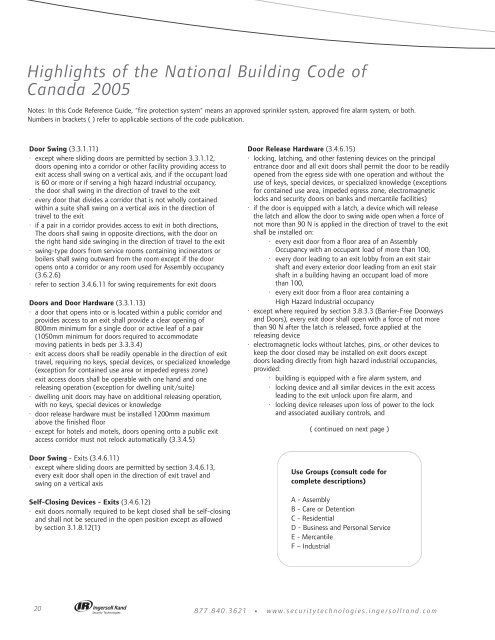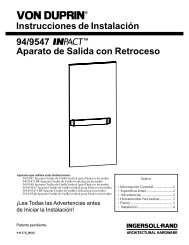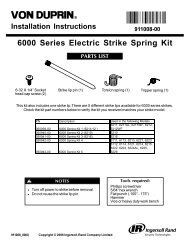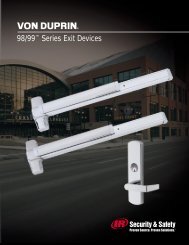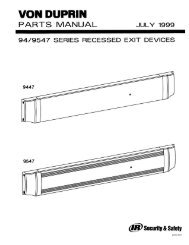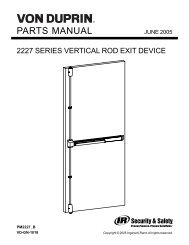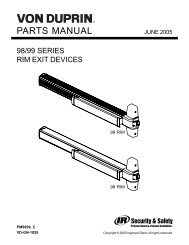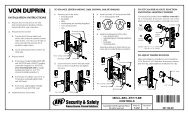Fire, Life Safety & Accessibility Codes - Von Duprin
Fire, Life Safety & Accessibility Codes - Von Duprin
Fire, Life Safety & Accessibility Codes - Von Duprin
Create successful ePaper yourself
Turn your PDF publications into a flip-book with our unique Google optimized e-Paper software.
Highlights of the National Building Code of<br />
Canada 2005<br />
Notes: In this Code Reference Guide, "fire protection system" means an approved sprinkler system, approved fire alarm system, or both.<br />
Numbersinbrackets()refertoapplicable sections of the code publication.<br />
Door Swing (3.3.1.11)<br />
· except where sliding doors are permitted by section 3.3.1.12,<br />
doors opening into a corridor or other facility providing access to<br />
exit access shall swing on a vertical axis, and if the occupant load<br />
is 60 or more or if serving a high hazard industrial occupancy,<br />
the door shall swing in the direction of travel to the exit<br />
· every door that divides a corridor that is not wholly contained<br />
within a suite shall swing on a vertical axis in the direction of<br />
travel to the exit<br />
· if a pair in a corridor provides access to exit in both directions,<br />
The doors shall swing in opposite directions, with the door on<br />
the right hand side swinging in the direction of travel to the exit<br />
· swing-type doors from service rooms containing incinerators or<br />
boilers shall swing outward from the room except if the door<br />
opens onto a corridor or any room used for Assembly occupancy<br />
(3.6.2.6)<br />
· refer to section 3.4.6.11 for swing requirements for exit doors<br />
Doors and Door Hardware (3.3.1.13)<br />
· a door that opens into or is located within a public corridor and<br />
provides access to an exit shall provide a clear opening of<br />
800mm minimum for a single door or active leaf of a pair<br />
(1050mm minimum for doors required to accommodate<br />
moving patients in beds per 3.3.3.4)<br />
· exit access doors shall be readily openable in the direction of exit<br />
travel, requiring no keys, special devices, or specialized knowledge<br />
(exception for contained use area or impeded egress zone)<br />
· exit access doors shall be operable with one hand and one<br />
releasing operation (exception for dwelling unit/suite)<br />
· dwelling unit doors may have on additional releasing operation,<br />
with no keys, special devices or knowledge<br />
· door release hardware must be installed 1200mm maximum<br />
above the finished floor<br />
· except for hotels and motels, doors opening onto a public exit<br />
access corridor must not relock automatically (3.3.4.5)<br />
Door Swing - Exits (3.4.6.11)<br />
· except where sliding doors are permitted by section 3.4.6.13,<br />
every exit door shall open in the direction of exit travel and<br />
swing on a vertical axis<br />
Self-Closing Devices - Exits (3.4.6.12)<br />
· exit doors normally required to be kept closed shall be self-closing<br />
and shall not be secured in the open position except as allowed<br />
by section 3.1.8.12(1)<br />
Door Release Hardware (3.4.6.15)<br />
· locking, latching, and other fastening devices on the principal<br />
entrance door and all exit doors shall permit the door to be readily<br />
opened from the egress side with one operation and without the<br />
use of keys, special devices, or specialized knowledge (exceptions<br />
for contained use area, impeded egress zone, electromagnetic<br />
locks and security doors on banks and mercantile facilities)<br />
· if the door is equipped with a latch, a device which will release<br />
the latch and allow the door to swing wide open when a force of<br />
not more than 90 N is applied in the direction of travel to the exit<br />
shall be installed on:<br />
· every exit door from a floor area of an Assembly<br />
Occupancy with an occupant load of more than 100,<br />
· every door leading to an exit lobby from an exit stair<br />
shaft and every exterior door leading from an exit stair<br />
shaft in a building having an occupant load of more<br />
than 100,<br />
· every exit door from a floor area containing a<br />
High Hazard Industrial occupancy<br />
· except where required by section 3.8.3.3 (Barrier-Free Doorways<br />
and Doors), every exit door shall open with a force of not more<br />
than 90 N after the latch is released, force applied at the<br />
releasing device<br />
· electromagnetic locks without latches, pins, or other devices to<br />
keep the door closed may be installed on exit doors except<br />
doors leading directly from high hazard industrial occupancies,<br />
provided:<br />
· building is equipped with a fire alarm system, and<br />
· locking device and all similar devices in the exit access<br />
leading to the exit unlock upon fire alarm, and<br />
· locking device releases upon loss of power to the lock<br />
and associated auxiliary controls, and<br />
( continued on next page )<br />
Use Groups (consult code for<br />
complete descriptions)<br />
A - Assembly<br />
B - Care or Detention<br />
C - Residential<br />
D - Business and Personal Service<br />
E - Mercantile<br />
F – Industrial<br />
20 877.840.3621 • www.securitytechnologies.ingersollrand.com


